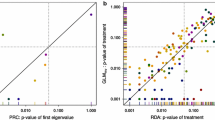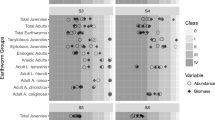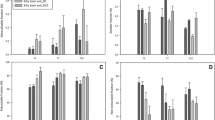Abstract
The effects of the fungicide carbendazim (formulation Derosal®) on enchytraeids were determined in Terrestrial Model Ecosystem (TME) tests. TMEs consisted of intact soil columns (diameter 17.5 cm; length 40 cm) taken from three grassland sites (Amsterdam (The Netherlands), Bangor (Wales, England) and Flörsheim (Germany)) or an arable site (Coimbra (Portugal)). Results for each TME site were evaluated using the multivariate Principal Response Curve (PRC) method. The resulting No-Observable Effect Concentrations (NOECs) for the community were compared with the NOECs generated by univariate statistical methods. Furthermore, the EC50s (median effect concentrations) for the three taxa with the highest taxon weights determined by the PRC were compared with EC50s for the other endpoints. In eight out of 16 cases the PRC revealed the lowest NOEC for the enchytraeid species community. The lowest EC50s with the closest 95% confidence limits were calculated for the abundance of the three taxa with the highest taxon weights identified by the PRC. The EC50s ranging from 0.19–2.79 mg carbendazim/kg soil are similar to values from laboratory toxicity studies reported in the literature. Therefore, PRC is a useful instrument to analyse microcosm and mesocosm experiments; it allows for determination of NOECs for the species community (NOECcommunity), the evaluation of the taxa with the most pronounced treatment-related decrease in abundance and of the calculation of meaningful EC50 values for those. The resulting NOECcommunity and EC50 values offer a comprehensive tool for the risk assessment of chemicals at the ecosystem level.




Similar content being viewed by others
References
Abrahamsen G (1969) Enchytraeus norvegicus sp. nov.: a new species of Enchytraeidae (Oligochaeta) from Norway. Norw J Zool 17:161–164
Cairns J Jr (1984) Multispecies toxicity testing. Environ Toxicol Chem 3:1–3
Cuppen JGM, Van den Brink PJ, Camps E, Uil KF, Brock TCM (2000) Impact of the fungicide carbendazim in freshwater microcosms. I. Water quality, breakdown of particulate organic matter and responses of macroinvertebrates. Aquat Toxicol 48:233–250
Didden WAM (1993) Ecology of terrestrial Enchytraeidae. Pedobiologia 37:2–29
Didden WAM, Fruend HL, Graefe U (1997) Enchytraeids. In: Benckiser G (ed) Fauna in soil ecosystems—recycling processes, nutrient fluxes and agricultural production. Marcel Dekker, Incorporation, New York, USA, pp 135–172
Didden WAM, Römbke J (2001) Enchytraeids as indicator organisms for chemical stress in terrestrial ecosystems. Ecotoxicol Environ Safe 50:25–43
Dózsa-Farkas K (1992a) List of Enchytraeid Synonyma. Newslett Enchytraeidae 3:16–46
Dózsa-Farkas K (1992b) Über die vertikale Verbreitung der Enchytraeiden (Oligochaeta: Enchytraeidae) in einem Hainbuchen-Eichenwald Ungarns. Opuscula Zoologica Budapest 25:61–74
EC (2002) Guidance document on aquatic ecotoxicology. Working Document SANCO/3268/2002 rev.4 (final), 17 October 2002 under Council Directive 91/414/EEC. European Commission, Brussels
EPPO (2003) Environmental risk assessment for plant protection products. Soil organisms and functions, Chapt. 8. Revised version. European and Mediterranean Plant Protection Organization, EPPO Bull 33:195–209
Federschmidt A (1994) Die Oligochätenfauna zweier Ökosysteme auf Lößlehm unter Berücksichtigung der Auswirkungen von Chemikalienstress. Ph.D. thesis, Johann Wolfgang Goethe Universität, Frankfurt/M, Germany
Frampton GK, Van den Brink PJ, Gould P (2000) Effects of spring precipitation on a temperate arable collembolan community analysed using Principal Response Curves. Appl Soil Ecol 14:231–248
Gillett JW, Witt JM (1980) Chemical evaluation: projected evaluation of terrestrial microcosm technology. In: Giesy JP Jr (ed) Microcosms in ecological research. National Technical Information Center, US Department of Energy, Springfield, Virginia, USA, pp 1008–1033
Graefe U (1989) Systematische Untersuchungen an der Gattung Achaeta (Enchytraeidae, Clitellata) 2. Beschreibung von vier neuen Arten. Mitt Hamb Zool Mus Inst 86:127–131
Graefe U, Schmelz R (1999) Indicator values, strategy, types and life forms of terrestrial Enchytraeidae and other microannelids. Newslett Enchytraeidae 6:59–68
Haanstra L, Doelman P, Oude Voshaar JH (1985) The use of sigmoidal dose response curves in soil ecotoxicological research. Plant Soil 84:293–297
Healy B (1980) Distribution of terrestrial Enchytraeidae in Ireland. Pedobiologia 20:159–175
Heck M, Römbke J (1991) Two new species of Achaeta (Enchytraeidae, Oligochaeta) from meadow and pasture soils of Germany. Zool Scr 20:215–220
ISO (2004) Soil quality—sampling of soil invertebrates—Part 3: sampling and soil extraction of enchytraeids. ISO guideline 23661-3. International Organisation for Standardisation, Geneva
Jones SE, Williams DJ, Holliman PJ, Förster B, Van Gestel CAM, Rodrigues JML, Baumann H-J, Taylor N (2004) Ring-testing and field-validation of a Terrestrial Model Ecosystem (TME)—an instrument for testing potentially harmful substances: fate of the model chemical carbendazim. Ecotoxicology 13:29–42
Knacker T, Van Gestel CAM, Jones SE, Soares AMVM, Schallnass H-J, Förster B, Edwards CA (2004) Ring-testing and field-validation of a Terrestrial Model Ecosystem (TME)—an instrument for testing potentially harmful substances: conceptual approach and study design. Ecotoxicology 13:9–27
Koolhaas JE, Van Gestel CAM, Römbke J, Soares AMVM, Jones SE (2004) Ring-testing and field-validation of a Terrestrial Model Ecosystem (TME)—an Instrument for testing potentially harmful substances: effects of carbendazim on soil microarthropod communities. Ecotoxicology 13:75–88
Landis WG, Matthews RA, Matthews GB (1997) Design and analysis of multispecies toxicity tests for pesticide registration. Ecol Appl 7:1111–1116
Moser T (2004) Auswirkungen des Fungizids Carbendazim auf Enchytraeidae (Annelida, Oligochaeta) in terrestrischen Modellökosystemen und im Freiland. Ph.D. thesis, Johann Wolfgang Goethe-Universtät, Frankfurt/Main, Germany
Moser T, Van Gestel CAM, Jones SE, Koolhaas JE, Rodrigues JML, Römbke J (2004) Ring-testing and field-validation of a Terrestrial Model Ecosystem (TME)—an instrument for testing potentially harmful substances: effects of carbendazim on enchytraeids. Ecotoxicology 13:89–103
Nielsen CO, Christensen B (1959) The Enchytraeidae, critical revision and taxonomy of European species. Nat Jutl 8–9:1–160
Nielsen CO, Christensen B (1961) The Enchytraeidae, critical revision and taxonomy of European species. Nat Jutl 10(Supplement 1):1–23
Nielsen CO, Christensen B (1963) The Enchytraeidae, critical revision and taxonomy of European species. Nat Jutl 10(Supplement 2):1–19
Römbke J, Moser T (1999) Organisation and performance of an international ringtest for the validation of the Enchytraeid reproduction test. UBA-Text 4/99, Berlin, Germany
Rota E (1994) Enchytraeidae (Oligochaeta) of western Anatolia: taxonomy and faunistics. Boll Zool 61:241–260
Rota E (1995) Italian Enchytraeidae. Boll Zool 62:183–231
Rota E, Healy B (1999) A taxonomic study of some Swedish Enchytraeidae (Oligochaeta) with descriptions of four new species and notes on the genus Fridericia. J Nat Hist 33:29–64
Schmelz RM (2003) Taxonomy of Fridericia (Enchytraeidae, Oligochaeta). Critical revision of species with morphological and biochemical methods. Abh Naturwiss Ver Hamburg 38:488
Sheppard SC (1997) Toxicity testing using microcosms. In: Tarradellas J, Bitton G, Rossel D (eds) Soil ecotoxicology. Lewis Publisher, Boca Raton, USA, pp 345–373
Smit CE, Schouten AJ, Van den Brink PJ, van Esbrock MLP, Posthuma L (2002) Effects of zinc contamination on a natural nematode community in outdoor soil mesocosms. Arch Environ Contam Toxicol 42:205–216
Ter Braak CJF, Smilauer P (1998) CANOCO reference manual and user’s guide to canoco for windows. Software for canonical community ordination (version 4). MicroComputer Power, Ithaca, New York, USA
Van den Brink PJ, Ter Braak CJF (1998) Multivariate analysis of stress in experimental ecosystems by Principal Response Curves and similarity analysis. Aquat Ecol 32:163–178
Van den Brink PJ, Ter Braak CJF (1999) Principal response curves: analysis of time-dependent multivariate responses of biological community to stress. Environ Toxicol Chem 18:138–148
Van den Brink P, Van Donk E, Gylstra R, Crum S, Brock T (1995) Effects of chronic low concentrations of the pesticides chloropyrifos and atrazine in indoor freshwater microcosms. Chemosphere 31:3181–3200
Van den Brink P, Van Wijngaarden RPA, Gylstra R, Lucassen WGH, Brock TCM, Leeuwangh P (1996) Effects of the insecticide Dursban 4E (active ingredient chloropyrifos) in outdoor experimental ditches: II. Invertebrate community responses and recovery. Environ Toxicol Chem 15:1143–1153
Van Voris P, Tolle DA, Arthur MF (1985) Experimental terrestrial soil-core microcosm test protocol. EPA/600/3–85/047 PNL-5450, UC-11, United States Environmental Protection Agency, Washington, USA
Velthorst EJ (1993) Manual for chemical water analysis. Department of Soil Science and Geology, Agricultural University, Wageningen, The Netherlands
Acknowledgements
This work was partly conducted in the frame of the TME-project, which was financially supported by the European Union (Project No. ENV4-CT97-0470). The statistical advice given by Hans-Toni Ratte is gratefully acknowledged.
Author information
Authors and Affiliations
Corresponding author
Rights and permissions
About this article
Cite this article
Moser, T., Römbke, J., Schallnass, HJ. et al. The use of the multivariate Principal Response Curve (PRC) for community level analysis: a case study on the effects of carbendazim on enchytraeids in Terrestrial Model Ecosystems (TME). Ecotoxicology 16, 573–583 (2007). https://doi.org/10.1007/s10646-007-0169-6
Received:
Accepted:
Published:
Issue Date:
DOI: https://doi.org/10.1007/s10646-007-0169-6




